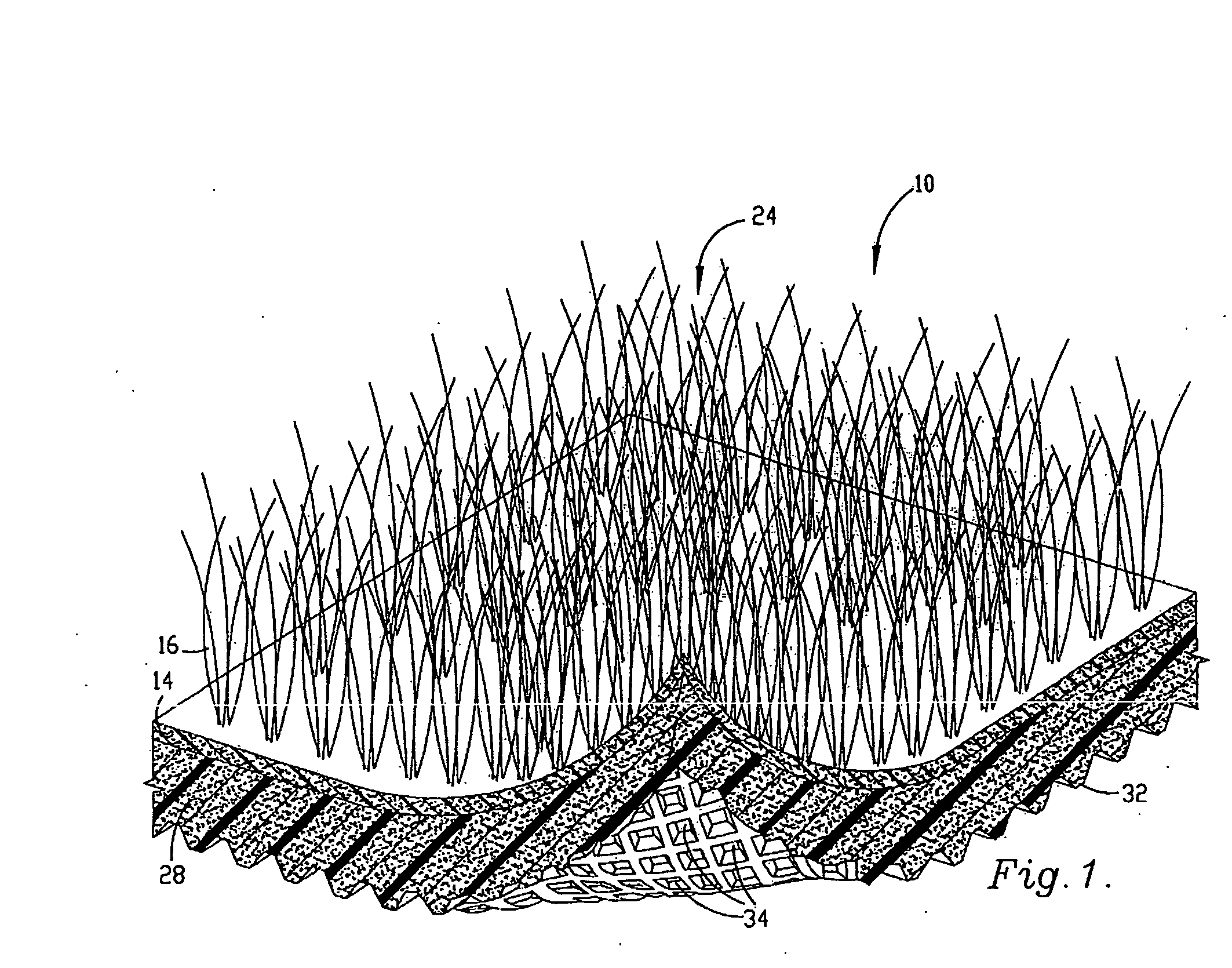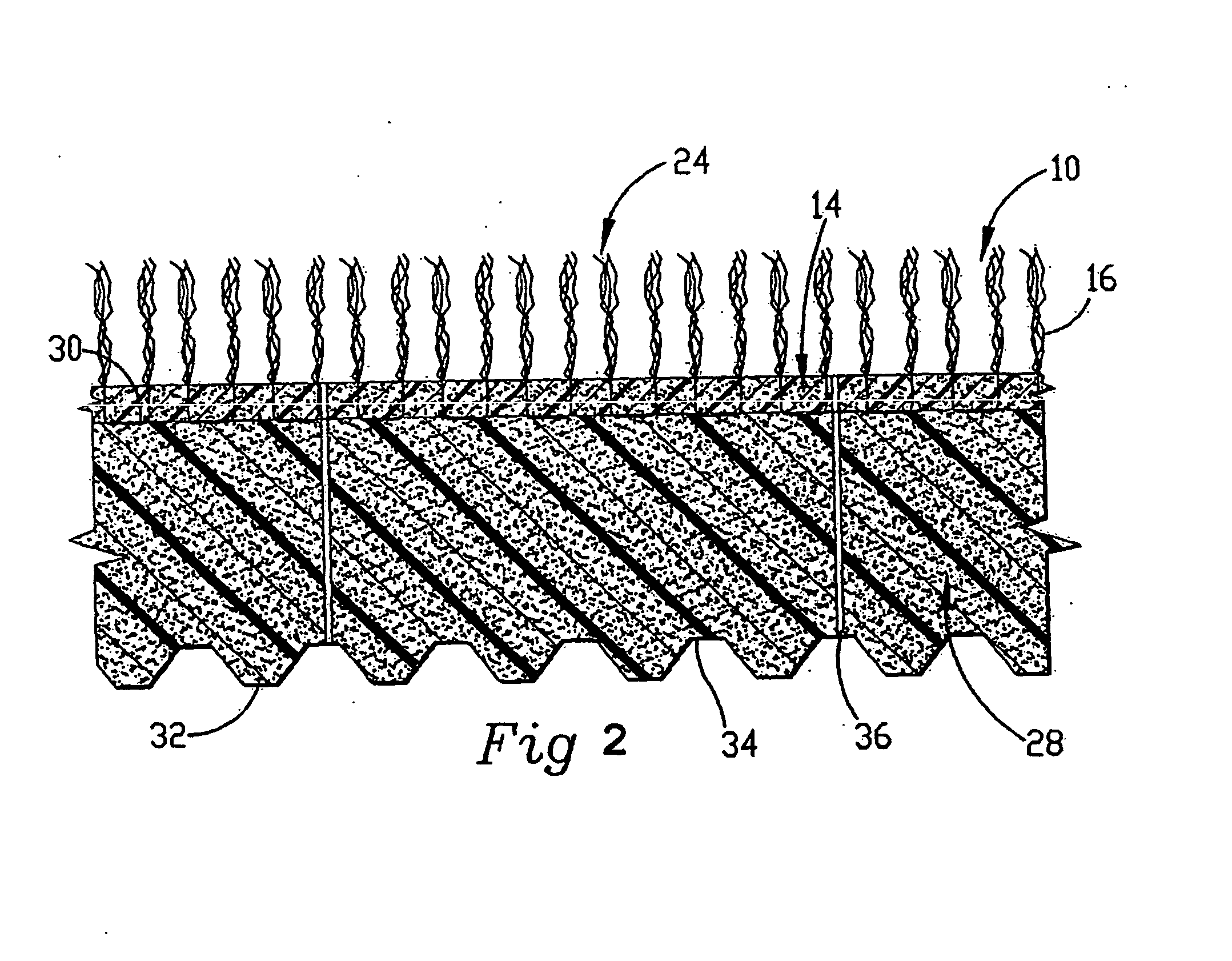Rubber Compositions, Methods of Making Rubber Compositions Rubber and Rubber-Containing Articles
a technology of compositions and rubber, applied in the field of compositions of rubber, methods of making rubber compositions rubber and rubbercontaining articles, can solve the problems of tensile strength and dynamic properties, low levels (up to 10 or 15 wt%), and high cost of rubber, so as to improve bonding, enhance tuft lock, and optimise cure system and sulphur level
- Summary
- Abstract
- Description
- Claims
- Application Information
AI Technical Summary
Benefits of technology
Problems solved by technology
Method used
Image
Examples
examples ii , iii
EXAMPLES II, III
Formulation and Mixing Details
[0097] The formulations given below show a NR / SBR compound (Example II) and a NBR compound (Example III), both containing just over 40% by weight of 60 mesh rubber dust. Each formulation is successfully mixed and cured to give matting products with satisfactory properties. Changes to the formulations to achieve compound optimisation, including the grade and quantity of the liquid rubber used, are quite acceptable, providing the changes do not reduce the effectiveness of the liquid polymer within the system. Similarly, the mixing method employed suited the equipment available for the development work, and should not be considered prescriptive. The fill factor and addition times will need to be established to suit the machine in which the compound is mixed, although it is recommended that the dump temperature does not exceed 110° C. so that an adequate scorch safety can be maintained. An internal mixer with tangential rotors was used for...
example ii
[0098]
TABLE 3Natural Rubber / SBRIngredientsphrPre-masticated NR32.250100 phr NR / 7.5 phr Pepton 66. ML1 +4@100° C. 30 tot 55DPR 4010.000Liquid NR Supplied by ElementisSBR 150260.000N33940.000Aromatic Process Oil40.000Rubber Dust135.00060 mesh from ground tyre treadZinc Oxide4.000Stearic acid2.000Antidegradant BPH1.500Non-staining (Vulkanox BKF)Antidegradant MMBI1.000Non-staining (Vulcanox ZMB2 / C5)TMTD - 80%0.250TBBS1.300Soluble Sulphur2.750TOTAL330.050S.G.1.120Hardness50 IRHDMixed using a 2.6 litre capacity laboratory Banbury mixer withtangential rotor mixing action.Fill Factor95%Mixing Cycle:(Time from Start)Natural Rubber / SBR / DPR40 0 minutesBlack / Oil / Rubber Dust0.5 minutesZinc Oxide / Stearic Acid1.0 minutesAntidegradants / Cure System1.5 minutesDump to temperature @ 110° C.MDR @180° C.ML2.22ts20.77t500.81t901.44MH6.81
Key / Notes
NR: natural rubber
DPR40: liquid NR: viscosity ˜40,000 cps @ 38° C. avge MW 32,000
SBR 1502: general purpose grade SBR; ML 1 + 4 (100° C.) = 52
N339: HA furnace ...
example iii
[0099]
TABLE 4NitrileIngredientsPhrNBR 34.5080.000Nipol 1312 LV20.000(Supplied by Zeon)N66040.000Rubber Dust110.00060 mesh from ground W.O.M. mat edgetrimmingsD.O.P.10.000Zinc Oxide5.000Stearic Acid1.000A.D.P.A.2.000(Permanax BLW)CBS2.000TMTM0.500MC Sulphur2.000TOTAL272.500S.G.1.150Hardness50 IRHDMixed using a 2.6 litre capacity laboratory Banbury mixer withtangential rotor mixing action.Fill Factor95%Mixing Cycle:(Time from Start)NBR / Nipol 1312 LV 0 minutesBlack / Oil / Rubber Dust / Sulphur0.5 minutesZinc Oxide / Stearic Acid1.0 minutesAntidegradants / Accelerators1.5 minutesDump to temperature @ 110° C.MDR @180° C.ML1.26ts20.50t500.54t900.76MH8.17
Key / Notes
NBR: 50 is the Mooney viscosity ML 1 + 4 @ 100° C. 34 is acrylonitrile content
Nipol: low-viscosity NBR ˜29% ACN Brookfield viscosity range 9000-16000 (sample was 12000)
ADPA: anti-oxidant / anti-ozonant: conventional (a p-phenylene diamine compound)
CBS: accelerator: cyclohexylbenzothiazyl sulphenamide
TMTM: accelerator: tetramethyl thiura...
PUM
| Property | Measurement | Unit |
|---|---|---|
| Fraction | aaaaa | aaaaa |
| Thickness | aaaaa | aaaaa |
| Fraction | aaaaa | aaaaa |
Abstract
Description
Claims
Application Information
 Login to View More
Login to View More - R&D
- Intellectual Property
- Life Sciences
- Materials
- Tech Scout
- Unparalleled Data Quality
- Higher Quality Content
- 60% Fewer Hallucinations
Browse by: Latest US Patents, China's latest patents, Technical Efficacy Thesaurus, Application Domain, Technology Topic, Popular Technical Reports.
© 2025 PatSnap. All rights reserved.Legal|Privacy policy|Modern Slavery Act Transparency Statement|Sitemap|About US| Contact US: help@patsnap.com



